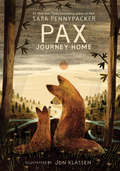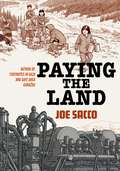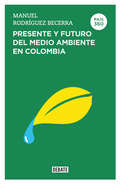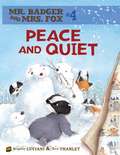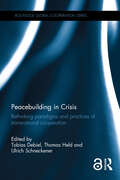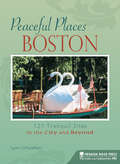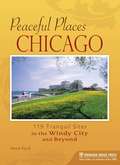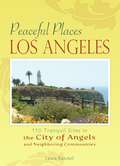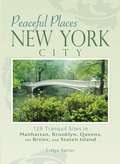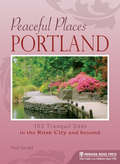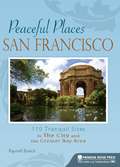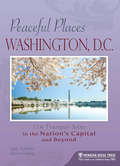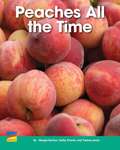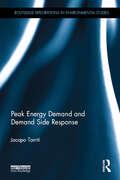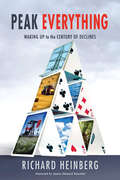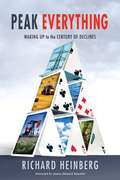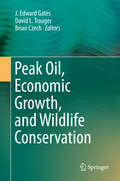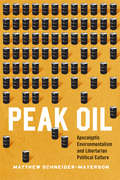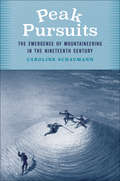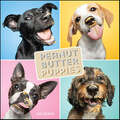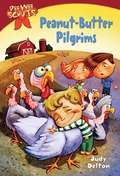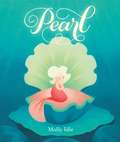- Table View
- List View
Pax, Journey Home (Pax)
by Sara PennypackerFrom bestselling and award-winning author Sara Pennypacker comes the long-awaited sequel to Pax; this is a gorgeously crafted, utterly compelling novel about chosen families and the healing power of love. <P><P> It’s been a year since Peter and his pet fox, Pax, have seen each other. Once inseparable, they now lead very different lives. <P><P> Pax and his mate, Bristle, have welcomed a litter of kits they must protect in a dangerous world. Meanwhile Peter—newly orphaned after the war, racked with guilt and loneliness—leaves his adopted home with Vola to join the Water Warriors, a group of people determined to heal the land from the scars of the war. <P><P> When one of Pax's kits falls desperately ill, he turns to the one human he knows he can trust. And no matter how hard Peter tries to harden his broken heart, love keeps finding a way in. Now both boy and fox find themselves on journeys toward home, healing—and each other, once again. <P><P> As he did for Pax, Jon Klassen, New York Times bestseller, Caldecott medalist, and two-time Caldecott Honoree, has created stunning jacket and interior illustrations. <P><P><b>A New York Times Best Seller</b>
Paying the Land
by Joe SaccoNAMED A BEST BOOK OF 2020 BY THE NEW YORK TIMES, THE GUARDIAN, THE BROOKLYN RAIL, THE GLOBE AND MAIL, POP MATTERS, COMICS BEAT, AND PUBLISHERS WEEKLYFrom the “heir to R. Crumb and Art Spiegelman” (Economist), a masterful work of comics journalism about indigenous North America, resource extraction, and our debt to the natural worldThe Dene have lived in the vast Mackenzie River Valley since time immemorial, by their account. To the Dene, the land owns them, not the other way around, and it is central to their livelihood and very way of being. But the subarctic Canadian Northwest Territories are home to valuable resources, including oil, gas, and diamonds. With mining came jobs and investment, but also road-building, pipelines, and toxic waste, which scarred the landscape, and alcohol, drugs, and debt, which deformed a way of life.In Paying the Land, Joe Sacco travels the frozen North to reveal a people in conflict over the costs and benefits of development. The mining boom is only the latest assault on indigenous culture: Sacco recounts the shattering impact of a residential school system that aimed to “remove the Indian from the child”; the destructive process that drove the Dene from the bush into settlements and turned them into wage laborers; the government land claims stacked against the Dene Nation; and their uphill efforts to revive a wounded culture.Against a vast and gorgeous landscape that dwarfs all human scale, Paying the Land lends an ear to trappers and chiefs, activists and priests, to tell a sweeping story about money, dependency, loss, and culture—recounted in stunning visual detail by one of the greatest cartoonists alive.
País 360. Presente y futuro del medioambiente en Colombia
by Manuel Rodríguez BecerraLa colección País 360 está compuesta por títulos de ensayo divulgativo que comprenden diversos aspectos de la realidad colombiana. Los más destacados investigadores y analistas presentan su mirada independiente sobre los temas que hoy definen nuestro país. Colombia es un país privilegiado por la naturaleza: con dos mares -cuya extensión es equivalente a su área continental-, una excepcional variedad de paisajes, ocupa el segundo lugar en diversidad de especies de flora y fauna y de ecosistemas del mundo, y el sexto en reservas de agua dulce. Sin embargo, esta riqueza se ha deteriorado en forma creciente en las últimas décadas y, además, está siendo afectada por la crisis ambiental mundial a la cual Colombia también ha contribuido. Manuel Rodríguez Becerra intenta responder con este libro a la demanda de información actualizada, clara y precisa de los lectores para comprender cuál es el presente y el futuro del medio ambiente en Colombia tomando en necesaria consideración el cambio climático, el declive de la biodiversidad y la contaminación que enfrenta nuestro planeta. Manuel Rodríguez Becerra es profesor emérito de la Universidad de los Andes, institución a la que se vinculó en 1971, y en donde ocupó los cargos de secretario general, vicerrector académico y decano de las facultades de Artes y Ciencias y Administración. Fue el primer ministro del Medio Ambiente de Colombia cuya creación coordinó. Hizo parte de la Comisión Mundial de Bosques y Desarrollo Sostenible y presidió el Panel Intergubernamental de Bosques de las Naciones Unidas. Su docencia e investigación se concentran en política ambiental, desarrollo sostenible y relaciones internacionales ambientales, las cuales lleva a cabo en la Facultad de Administración de la Universidad de los Andes. Cofundador de: el Foro Nacional Ambiental (1998) que hoy preside, Parques Naturales Nacionales Cómo Vamos (2017), el Centro de los Objetivos del Desarrollo Sostenible para América Latina y el Caribe (2018), y la Alianza para la Defensa de la Sabana de Bogotá (2019). Es autor de más de 25 libros y columnista de El Tiempo
Peace and Quiet (Fountas & Pinnell LLI Blue)
by Brigitte Luciani Eve Tharlet Carol BurrellCan this family keep the peace when they're cooped up together underground? <P><P> The days are getting colder. The badgers' bellies are getting rounder, and the foxes' fur is growing longer. That can only mean one thing: winter is coming! Ginger wants to sing and play and hunt in the snow. She wishes her badger brother, Grub, would join her, but he is busy taking daylong naps. She needs a perfect plan to make the whole family happy. But what do you do with a badger who only wants peace and quiet?
Peacebuilding and Natural Resource Governance After Armed Conflict: Sierra Leone and Liberia
by Michael D. BeeversThis book argues that a set of persuasive narratives about the links between natural resource, armed conflict and peacebuilding have strongly influenced the natural resource interventions pursued by international peacebuilders. The author shows how international peacebuilders active in Liberia and Sierra Leone pursued a collective strategy to transform “conflict resources” into “peace resources” vis-à-vis a policy agenda that promoted “securitization” and “marketization” of natural resources. However, the exclusive focus on securitization and marketization have been counterproductive for peacebuilding since these interventions render invisible issues connected to land ownership, environmental protection and sustainable livelihoods and mirror pre-war governing arrangements in which corruption, exclusion and exploitation took root. Natural resource governance and peacebuilding must go beyond narrow debates about securitization and marketization, and instead be a catalyst for trust–building and cooperation that has a local focus, and pursues an inclusive agenda that not only serves the cause of peace, but the cause of people.
Peacebuilding in Crisis: Rethinking Paradigms and Practices of Transnational Cooperation (Routledge Global Cooperation Series)
by Thomas Held Tobias Debiel Ulrich SchneckenerThe 1990s saw a constant increase in international peace missions, predominantly led by the United Nations, whose mandates were more and more extended to implement societal and political transformations in post-conflict societies. However, in many cases these missions did not meet the high expectations and did not acquire a sufficient legitimacy on the local level. Written by leading experts in the field, this edited volume brings together ‘liberal’ and ‘post-liberal’ approaches to peacebuilding. Besides challenging dominant peacebuilding paradigms, the book scrutinizes how far key concepts of post-liberal peacebuilding offer sound categories and new perspectives to reframe peacebuilding research. It thus moves beyond the ‘liberal’–‘post-liberal’ divide and systematically integrates further perspectives, paving the way for a new era in peacebuilding research which is theory-guided, but also substantiated in the empirical analysis of peacebuilding practices. This book will be essential reading for postgraduate students and scholar-practitioners working in the field of peacebuilding. By embedding the subject area into different research perspectives, the book will also be relevant for scholars who come from related backgrounds, such as democracy promotion, transitional justice, statebuilding, conflict and development research and international relations in general.
Peacebuilding in Crisis: Rethinking Paradigms and Practices of Transnational Cooperation (Routledge Global Cooperation Series)
by Thomas Held Tobias Debiel Ulrich SchneckenerThe 1990s saw a constant increase in international peace missions, predominantly led by the United Nations, whose mandates were more and more extended to implement societal and political transformations in post-conflict societies. However, in many cases these missions did not meet the high expectations and did not acquire a sufficient legitimacy on the local level. Written by leading experts in the field, this edited volume brings together ‘liberal’ and ‘post-liberal’ approaches to peacebuilding. Besides challenging dominant peacebuilding paradigms, the book scrutinizes how far key concepts of post-liberal peacebuilding offer sound categories and new perspectives to reframe peacebuilding research. It thus moves beyond the ‘liberal’–‘post-liberal’ divide and systematically integrates further perspectives, paving the way for a new era in peacebuilding research which is theory-guided, but also substantiated in the empirical analysis of peacebuilding practices.This book will be essential reading for postgraduate students and scholar-practitioners working in the field of peacebuilding. By embedding the subject area into different research perspectives, the book will also be relevant for scholars who come from related backgrounds, such as democracy promotion, transitional justice, statebuilding, conflict and development research and international relations in general.
Peaceful Places: Boston
by Lynn SchweikartThe fifth in a new series, each one set in a U.S. metropolis, Peaceful Places: Boston leads the reader on an unexpected path to secret delights shared by its insider author. This new title in an unusual guidebook series is for everyone who yearns for a little peace and quiet amidst the urban hubbub. The book entices readers with 120 tranquil oases, in Boston and beyond. There are enchanting walks, historic sites, museums and galleries, outdoor habitats, parks and gardens, quiet tables, spiritual enclaves, inspiring vistas, and urban surprises, all described from the perspective of a local who knows where to find serenity, in both familiar and unexpected places.
Peaceful Places: Chicago
by Anne FordThe fourth in a new series, each one set in a U.S. metropolis, Peaceful Places: Chicago leads the reader on an unexpected path. Author Anne Ford uncovers hidden pockets of relaxation throughout the windy city. Her unique guide reveals the surprising gardens, vistas, sanctuaries, café respites, and neighborhood strolls that make up Chicago communities from downtown to the 'burbs. Readers will discover new destinations, and they will find tips on when to visit grand and diminutive locales for a bit of quiet time.
Peaceful Places: Los Angeles
by Laura RandallDuring her 1930s screenwriting days in Hollywood, wordsmith Dorothy Parker famously pegged Los Angeles as "72 suburbs in search of a city." Today even more communities radiate from the downtown core, creating a metropolitan universe of noise, speed, and congestion amid the glitter and bling. Los Angeles-based author Laura Randall knows just where to go for some urban stress relief. The second in a new guidebook series spotlighting calming sites in major U.S. cities, Peaceful Places: Los Angeles serves up a medley of soothing sanctuaries, panoramic vistas, fragrant gardens, restorative hideaways, and unexpected urban oases. Altogether, the entries present a feast for all five of the senses - not to mention the sixth sense, that perception that "this place quiets my soul."
Peaceful Places: New York City
by Evelyn KanterSensory overload may make for exciting urban life, but sometimes it's just too much. Kicking off a new series of city guides, 100 Peaceful Places: New York City leads both residents and visitors on an unexpected path. Author Evelyn Kanter shares the inspiring, restorative pockets she has come to love over a lifetime of exploring and living in New York City. While her native Manhattan serves up many calming spots, this unique guide reflects New York's colorful ethnic diversity, revealing the unexpected sanctuaries, gardens, vistas, beaches, neighborhood strolls, and peaceful cafés that can be found throughout the city. And by knowing when to go or where to head once inside, visitors can escape the crowds even at popular, tourist-heavy destinations like Grand Central Station and the Metropolitan Museum of Art. As a bonus, many of the sites offer free admission, and none are exorbitantly expensive.
Peaceful Places: Portland
by Paul GeraldEverybody knows about Portland's food scene, its outdoor recreation, its bike lanes, beer pubs, and coffee shops. Whether you call it Stumptown or Bridgetown-or even PDX-Portland has been mocked as the city "where young people go to retire." But seemingly every weekend there's a festival, organized bike ride, political march, or something else clamoring for participation. In short, Portland is a happening town.But sometimes folks just want to chill out, to go where there isn't much happening. They might want to enjoy a quiet meal, take a walk in a park, curl up with a good book, or get out of town to some soul-soothing destination. With books covering all the other activities in town, where's the one that tells people where they can do .... well, not much?As of Fall 2012, the answer is Peaceful Places: Portland, written by Paul Gerald, the man who gave this town 60 Hikes Within 60 Miles of Portland and Breakfast in Bridgetown. This time, Gerald is off in search of peace and quiet, and he invites the reader along to quiet tables, parks and gardens, enchanting walks, outdoor habitats, and other retreats.Seeking out the places or times when the crowds will be elsewhere, Gerald will give you the essence of what each place is about-what makes it peaceful or inviting. But he does not stint on also giving you all the detailed info you need to find the place and get there at the crowd-free time.Sometimes, this will be a matter of discovery, as in "Do I really stand a chance of seeing a heron in the Pearl District?" Other times it may feel like being let in on a secret, like a meadow full of camas blooming within earshot of Interstate 205. Or maybe it's just the right time to hit just the right table for a romantic meal or some quality reading time.But the theme that carries throughout the book is a simple one: Portland is a great city, but it's still a city, and sometimes folks just need a break.
Peaceful Places: San Francisco
by Raynell BoeckThe third book in a new series of city guides, Peaceful Places: San Francisco features over 100 unexpected sanctuaries, gardens, vistas, beaches, neighborhood strolls, and quiet cafés that can be found throughout The City by the Bay. It gently guides travelers who are searching for an escape from the bustle of city life. Within the book are helpful tips and an insider's perspective on the best time to find peace and quiet at a wide array of locales, from resplendent gardens to scenic perches. Residents and visitors alike can use this guide to navigate their way through the diverse neighborhoods of San Francisco and its surrounding areas. Those searching for some tranquility amidst the vibrant - and sometimes overwhelming - streetscape of one of America's most sensory-infused cities will be pleased with the discoveries they make inside Peaceful Places: San Francisco.
Peaceful Places: Washington, D.C.
by Denis Collins Judy ColbertNative Washingtonians Judy Colbert and Denis Collins have grown up and lived amid some of the most exciting sightseeing in the country--in their own grand urban backyard. They share this knowledge in Peaceful Places: Washington, DC. Now readers can enjoy the sights without being elbow-to-elbow with visitors from around the country and the world. Their diverse peaceful "finds" unfold in 12 categories of tranquil spots: Day Trips & Overnights, Enchanting Walks, Historic Sites, Museums & Galleries, Outdoor Habitats, Parks and Gardens, Quiet Tables, Reading Rooms, Scenic Vistas, Shops & Services, Spiritual Enclaves, and Urban Surprises. Readers will find places that please the senses of smell, touch, hearing, sight, and taste.In addition to the beautifully written site descriptions, the concise entries also include vital information such as locations for the nearest Metro stations or local parking facilities, admission charges (and any free times), and operating hours. Plus, the authors provide a "peacefulness rating" based on three criteria: always peaceful, usually quite tranquil, or peaceful during the times or seasons specified in the peaceful place entry description.The entries are arranged three ways: alphabetically by name; by category (see all 12 listed above); and by area (keyed to the guidebook's maps). That is so readers can pick a quiet spot according to interest, mood, and location. Although most of the attractions are in the downtown, National Mall, and northwest sections of Washington, many escapes are located beyond those perimeters and on into Northern Virginia and Suburban Maryland.Peaceful Places: Washington, DC is not a coffee-table book. It's one to keep in the car, the briefcase, the backpack, or the purse. Whether the reader is a native, who has lived in D.C. long enough to be considered a native, or is a visitor with only a few hours between business meetings or a hectic tourist schedule, this book will be a treasured asset.
Peaches All the Time
by Tammy Jones Margie Burton Cathy FrenchIn Peaches All The Time, students learn that peaches need water to grow-but not too much. They also learn about irrigation. Students study how the quantity of peaches available for sale makes a difference in the cost.
Peak Energy Demand and Demand Side Response (Routledge Explorations in Environmental Studies)
by Jacopo TorritiWith different intensities, depending on the season, every morning and evening of any weekday there are the same peaks in electricity demand. Peaks can bring about significantly negative environmental and economic impacts. Demand Side Response is a relatively recent solution in Europe which has the potential to reduce peak demand and ease impending capacity shortages. Peak Energy Demand and Demand Side Response presents evidence on a set of Demand Side Response activities, ranging from price-based to incentive-based programmes and policies. Examples are drawn from different programmes for both residential and non-residential sectors of electricity demand, including Time of Use tariffs, Critical Peak Pricing Automated Demand Controllers and Ancillary Services. The book also looks at the actual energy saving impacts of smart meters, the activities which constitute peak demand and the potential opportunities associated with European smart grids and Capacity Markets. This is the first book presenting comprehensive analysis of the impacts, cost benefits and risks associated with Demand Side Response programmes and policies. It should be of interest to students, scholars and policy-makers in the areas of energy, environmental economics and applied economics.
Peak Everything
by Richard HeinbergThe twentieth century saw unprecedented growth in population, energy consumption, and food production. As the population shifted from rural to urban, the impact of humans on the environment increased dramatically.The twenty-first century ushered in an era of declines, in a number of crucial parameters: Global oil, natural gas, and coal extraction Yearly grain harvests Climate stability Population Economic growth Fresh water Minerals and ores, such as copper and platinum To adapt to this profoundly different world, we must begin now to make radical changes to our attitudes, behaviors, and expectations. Peak Everything addresses many of the cultural, psychological, and practical changes we will have to make as nature rapidly dictates our new limits. This latest book from Richard Heinberg, author of three of the most important books on Peak Oil, touches on the most important aspects of the human condition at this unique moment in time.A combination of wry commentary and sober forecasting on subjects as diverse as farming and industrial design, this book tells how we might make the transition from the Age of Excess to the Era of Modesty with grace and satisfaction, while preserving the best of our collective achievements. A must-read for individuals, business leaders, and policymakers who are serious about effecting real change. Richard Heinberg is a journalist, lecturer, and the author of seven books, including The Party's Over, Powerdown, and The Oil Depletion Protocol. He is one of the world's foremost Peak Oil educators.
Peak Everything: Waking Up to the Century of Declines
by Richard HeinbergHeinberg (New College of California's Campus for Sustainable Living) previously set forth the argument that the world's oil production is peaking and will henceforth go into decline in The Party's Over: Oil, War and the Fate of Industrial Societies. Here he collects 11 essays exploring some of the social, economic, ecological, and political implications of the end of the era of cheap energy. These implications arise out of the recognition that the arrival of peak oil portends also the peak of per-capita consumption levels, economic growth, cheap and easy mobility, technological change and invention, and political stability, but perhaps also the peak of economic inequality, environmental destruction, and greenhouse gas emissions. Distributed by Consortium Books Sales and Distribution. Annotation ©2008 Book News, Inc. , Portland, OR (booknews. com)
Peak Oil, Economic Growth, and Wildlife Conservation
by Brian Czech J. Edward Gates David L. TraugerThe proposed book focuses on one of the most important issues affecting humankind in this century - Peak Oil or the declining availability of abundant, cheap energy--and its effects on our industrialized economy and wildlife conservation. Energy will be one of the defining issues of the 21st Century directly affecting wildlife conservation wherever energy extraction is a primary economic activity and indirectly through deepening economic recessions. Since cheap, abundant energy has been at the core of our industrial society, and has resulted in the technological advancements we enjoy today, the peak in world oil extraction would potentially have major impacts on civilization unless we prepare well in advance. One potential economic solution covered in the book would be a Steady State Economy with a stable population and per capita consumption, particularly in such industrialized countries as the United States. Furthermore, the lack of cheap, abundant energy directly and indirectly affects conservation efforts by professional societies and federal and state agencies, and NGOs concerned with wildlife issues. We need to recognize these potential problems and prepare, as much as possible, for the consequences stemming from them.
Peak Oil: Apocalyptic Environmentalism and Libertarian Political Culture
by Matthew Schneider-MayersonIn recent years, the concept of "peak oil"--the moment when global oil production peaks and a train of economic, social, and political catastrophes accompany its subsequent decline--has captured the imagination of a surprisingly large number of Americans, ordinary citizens as well as scholars, and created a quiet, yet intense underground movement. In Peak Oil, Matthew Schneider-Mayerson takes readers deep inside the world of "peakists," showing how their hopes and fears about the postcarbon future led them to prepare for the social breakdown they foresee--all of which are fervently discussed and debated via websites, online forums, videos, and novels. By exploring the worldview of peakists, and the unexpected way that the fear of peak oil and climate change transformed many members of this left-leaning group into survivalists, Schneider-Mayerson builds a larger analysis of the rise of libertarianism, the role of oil in modern life, the political impact of digital technologies, the racial and gender dynamics of post-apocalyptic fantasies, and the social organization of environmental denial.
Peak Pursuits: The Emergence of Mountaineering in the Nineteenth Century
by Caroline SchaumannAn interdisciplinary cultural history of exploration and mountaineering in the nineteenth century European forays to mountain summits began in the late eighteenth and early nineteenth centuries with the search for plants and minerals and the study of geology and glaciers. Yet scientists were soon captivated by the enterprise of climbing itself, enthralled with the views and the prospect of &“conquering&” alpine summits. Inspired by Romantic notions of nature, early mountaineers idealized their endeavors as sublime experiences, all the while deliberately measuring what they saw. As increased leisure time and advances in infrastructure and equipment opened up once formidable mountain regions to those seeking adventure and sport, new models of masculinity emerged that were fraught with tensions. This book examines how written and artistic depictions of nineteenth-century exploration and mountaineering in the Andes, the Alps, and the Sierra Nevada shaped cultural understandings of nature and wilderness in the Anthropocene.
Peanut Butter Puppies
by Greg MurrayRescue-dog advocate and professional photographer Greg Murray has followed up on the fan favorite Peanut Butter Dogs with an even more irresistible theme: Peanut Butter Puppies. These adorable portraits of rescued dogs, captured in studio with colorful backgrounds and in delightfully amusing detail, will tug at your heartstrings. Prepare to swoon over Wallaby, the seven-month-old heeler; Archie, the eight-month-old Chihuahua; Fiona Wigglesworth, the eight-month-old Boston terrier; Zoey, the nine-month-old mastiff mix, and so many more! Each one-of-a-kind portrait is sure to make your day. Names, ages, and breed/mix accompany each portrait.
Peanut-Butter Pilgrims (Pee Wee Scouts #6)
by Judy DeltonAll the Pee Wee Scouts love to celebrate the holidays, but Thanksgiving is not Molly Duff's favorite one. In fact, Thanksgiving is big trouble for Molly. It's not so bad when the Pee Wees make baskets to hold food for poor people. And it's not so bad when they visit a turkey farm and Sonny Betz takes a turkey home with him. But when Mrs. Peters, their troop leader, tells them about the Pee Wee Thanksgiving play at the town hall, Molly shivers. She's not an actress! She'll forget all her lines. Everyone will laugh. Pilgrims and Indians. Turkeys going gobble, gobble. When you're a Pee Wee Scout, the show must go on! Read more fun books about the Pee Wee Scouts from Bookshare including: #2 Camp Ghost-Away, #9 Spring Sprouts, #12 Bad, Bad, Bunnies, and #33 Halloween Helpers.
Pearl
by Molly IdleCaldecott Honor author-illustrator Molly Idle dazzles with an original mermaid tale about how small, persistent actions can achieve great things.Sometimes the tiniest light can shine the brightest! Like the other mermaids of the deep, Pearl longs to care for the endless beaches, coral reefs, and towering kelp forests of her vast ocean world. So when her mother asks her to tend to a mere grain of sand, Pearl is heartbroken. It takes all her patience and determination to discover how even the littlest mermaid can transform the world.Caldecott Honor-winning author and artist Molly Idle has masterfully crafted a modern classic in this mesmerizing tale about the immense power of small actions.
